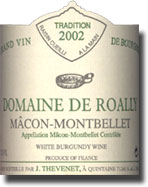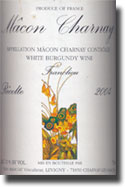| | |
| I remember once asking Joe Dressner why he didn’t import a Chablis. The answer was simple. There are only two growers in Chablis who harvest by hand, Vincent Dauvissat and François Raveneau, and they already have representation. | |
| Since Louis/Dressner only handles hand-harvested wine, there could be no Chablis in the portfolio. Joe seemed to regret this self-imposed constraint; no doubt he loves Chablis as much as I do. Why harvest by hand? Why adhere to these costly, strict production standards? Because they make better, more interesting, more healthy wine. And for whatever odd reason, Louis/Dressner wines are priced absurdly low. They are unsurpassed in terms of QPR value. 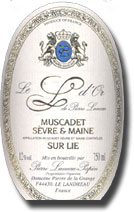 2002 Luneau-Papin Muscadet Sèvre & Maine Sur Lie Le L d’Or, $14.45 – 17, 12% alc. Find this wine: Medium straw color, with an intense core of under ripe green apple, a little quince, wet stones and rain water; good weight, excellent cut and a long finish. Very impressive already, and based on a delicious ’93 tasted about a year and a half ago, this should age well to its 10th birthday and beyond. Not your average Muscadet, and indeed, as concentrated as (if not more so than) any we’ve had the pleasure to enjoy. 2002 Luneau-Papin Muscadet Sèvre & Maine Sur Lie Le L d’Or, $14.45 – 17, 12% alc. Find this wine: Medium straw color, with an intense core of under ripe green apple, a little quince, wet stones and rain water; good weight, excellent cut and a long finish. Very impressive already, and based on a delicious ’93 tasted about a year and a half ago, this should age well to its 10th birthday and beyond. Not your average Muscadet, and indeed, as concentrated as (if not more so than) any we’ve had the pleasure to enjoy. 2002 Mas des Chimères Coteaux du Languedoc, $15.20, 14% alc. Find this wine: An old favorite from the early days of the Gang, and if it’s a bit more expensive than it used to be, (a.) what isn’t, and (b.) it’s still well worth the price tag. Ruby dark garnet from rim to rim, with a perfumed bouquet of black plum, blackberry, black cherry and a subtle note of sweet spice that carries over into the big, rich flavors with a solid earthy core. Showing considerable structure, a long lingering finish and just a little heat, this is a bit rough around the edges, but it has such an abundance of fruit, it’s almost impossible not to cozy up to already. Three to five years should smooth things out, and we’re happy to have this back. Now, if only we can get a steady supply of another old friend from LDM, the mouth-watering Château d’Oupia Minervois. 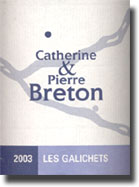 2003 Catherine & Pierre Breton Bourgueil Les Galichets, $17 – 20, 12% alc. Find this wine: Ruby dark garnet, with a bit of the barnyard over red and black currants and berries on the nose when first poured; the barnyard blows off fairly quickly to reveal a pretty floral character underneath. Showing a solid earthy core of black currant, blackberry and a hint of blueberry shaded with a subtle herbaceous note, this has real heft, a good dose of tannins and a long finish. It gets prettier and prettier as it opens, but is still a young wine that will benefit from some years in the cellar. This and the following two Bourgueil selections from the Bretons are like night and day when compared to the lighter, middleweight bottling from Kermit Lynch that we enjoyed in July. 2003 Catherine & Pierre Breton Bourgueil Les Galichets, $17 – 20, 12% alc. Find this wine: Ruby dark garnet, with a bit of the barnyard over red and black currants and berries on the nose when first poured; the barnyard blows off fairly quickly to reveal a pretty floral character underneath. Showing a solid earthy core of black currant, blackberry and a hint of blueberry shaded with a subtle herbaceous note, this has real heft, a good dose of tannins and a long finish. It gets prettier and prettier as it opens, but is still a young wine that will benefit from some years in the cellar. This and the following two Bourgueil selections from the Bretons are like night and day when compared to the lighter, middleweight bottling from Kermit Lynch that we enjoyed in July. 2002 Catherine & Pierre Breton Bourgueil Clos Senechal, $18.70 – 22, 11.7% alc. Find this wine: Dark garnet, with characteristics reminiscent of earthy red and black currants, herbaceous undertones and hints of anise and underbrush as it opens. Medium full bodied, with excellent structure, tannins to burn for some years yet, and a nice finish. Doesn’t have the floral note that the Les Galechets does, but that’s not a criticism; I like this a lot for exactly what it is. 2003 Catherine & Pierre Breton Bourgueil Nuits d’Ivresse, $22.95 – $27, 12% alc. Find this wine: Dark garnet color from rim to rim, with a tight nose at first, showing earthy black currant and a little Kiwi Black Shoe Polish; notes of raspberry, blueberry and hints of leather and forest floor emerge as it opens with air. Flavors echo on a medium full bodied frame, making for another pretty substantial Breton Bourgueil with excellent structure and a nice finish. Like the other two, this benefits from some time in a decanter before drinking, and while it will improve with several years in the cellar, it’s downright drinkable right now. ”Nuits d'Ivresse, or ‘The Drunken Nights,’ is from a selection of fruit that is vinified completely without the use of any sulfur, according to the vinification principals outlined by the late Jules Chauvet. There is a tiny amount added before the bottling to keep the wine stable in shipping, but it is so minimal as to be undetectable in testing.” – from the Louis/Dressner website 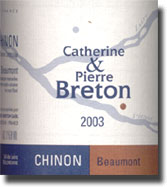 2003 Catherine & Pierre Breton Chinon Beaumont, $17.85 – 21, 12% alc. Find this wine: As much as I like the three Bourgueils, this dark garnet colored Cabernet Franc is my favorite of this foursome from the Bretons. Initially, it gives up earthy, briary, brambly black currant, blackberry and blueberry flavors and aromas, with excellent structure and good heft and presence; the earth and underbrush linger longest on the finish. The rich fruit and deep earthy qualities provide an interesting, almost startling contrast, but as it opens dramatically in the glass, a good hit of leather, some cola – root beer and even a hint of mahogany emerge, adding interest and complexity. If two hours in a decanter makes this much difference, what will some years in the cellar do for it? It’s a more muscular, extracted Cabernet Franc than those from Charles Joguet that we like so well, and Putnam and I agree that it will age effortlessly through 2013 and beyond. From 50 year old vines grown on clay and limestone. 2003 Catherine & Pierre Breton Chinon Beaumont, $17.85 – 21, 12% alc. Find this wine: As much as I like the three Bourgueils, this dark garnet colored Cabernet Franc is my favorite of this foursome from the Bretons. Initially, it gives up earthy, briary, brambly black currant, blackberry and blueberry flavors and aromas, with excellent structure and good heft and presence; the earth and underbrush linger longest on the finish. The rich fruit and deep earthy qualities provide an interesting, almost startling contrast, but as it opens dramatically in the glass, a good hit of leather, some cola – root beer and even a hint of mahogany emerge, adding interest and complexity. If two hours in a decanter makes this much difference, what will some years in the cellar do for it? It’s a more muscular, extracted Cabernet Franc than those from Charles Joguet that we like so well, and Putnam and I agree that it will age effortlessly through 2013 and beyond. From 50 year old vines grown on clay and limestone. James Laube of the Wine Spectator once wrote a column (July 31, 2003) explaining that Chardonnay is great because it is the ultimate “winemaker’s wine.” He pointed out that Chardonnay grows easily in different climates. It also makes a good, neutral base for flavor-enhancing intervention: barrel fermenting, new oak aging, lees contact, malolactic fermentation, non-malolactic fermentation, tropical fruit flavored yeast esters, acidification, sweetening – you name it. Chardonnay is the most nipped and tucked grape in the world. Hand-harvested and completely un-oaked, it is hard to imagine a better food wine. Racy, lemon flavored acidity advertises the wine’s youth and freshness. A classically “nutty” interior can be detected as well, though I suspect some readers have been abused by that term as it relates to any number of industrial Chardonnay concoctions on the market. No, this is the real stuff. This is what Chardonnay is actually supposed to taste like, not merely what it can be exploited to taste like.  Finally, we would be remiss in not mentioning Louis/Dressner’s Quinto do Infantado Ruby Port NV, Find this wine a delicious, semi – sweet after – dinner libation. We went through more than a few bottles of this fine stuff at Adams – Heritier and Associates during August, but never bothered to take any formal notes, we simply sipped and enjoyed. Quinto do Infantado is a Portuguese winery that grows its own grapes and makes all of its own wines (Vintage Port through basic Ruby) from Class A vineyards, as opposed to large shipping companies that buy grapes and make Ruby Port from Class E and F vineyards (click here for a more complete explanation of these variables), and the difference between the two in quality is remarkable. This ruby colored porto is medium full bodied, silky smooth and redolent with luscious plummy black cherry flavors and aromas. Despite the 19.5% alcohol content, it avoids any excess heat, and is anything but syrupy. This is now our house port, and we recommend that tasters exercise some restraint, because it’s way too easy to pour a second and third helping, although that’s fine too, if it’s not a school night. Finally, we would be remiss in not mentioning Louis/Dressner’s Quinto do Infantado Ruby Port NV, Find this wine a delicious, semi – sweet after – dinner libation. We went through more than a few bottles of this fine stuff at Adams – Heritier and Associates during August, but never bothered to take any formal notes, we simply sipped and enjoyed. Quinto do Infantado is a Portuguese winery that grows its own grapes and makes all of its own wines (Vintage Port through basic Ruby) from Class A vineyards, as opposed to large shipping companies that buy grapes and make Ruby Port from Class E and F vineyards (click here for a more complete explanation of these variables), and the difference between the two in quality is remarkable. This ruby colored porto is medium full bodied, silky smooth and redolent with luscious plummy black cherry flavors and aromas. Despite the 19.5% alcohol content, it avoids any excess heat, and is anything but syrupy. This is now our house port, and we recommend that tasters exercise some restraint, because it’s way too easy to pour a second and third helping, although that’s fine too, if it’s not a school night.
Reporting from Day-twah, Bastardo Other Recent Wine Explorations The Ridge Report - August, 2005 Winemaker Profile: Ian Hongell of Peter Lehmann Wines Back to the Underground Index | |


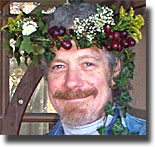
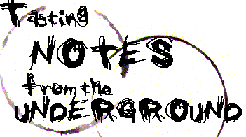

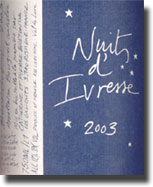 s reported by
s reported by 